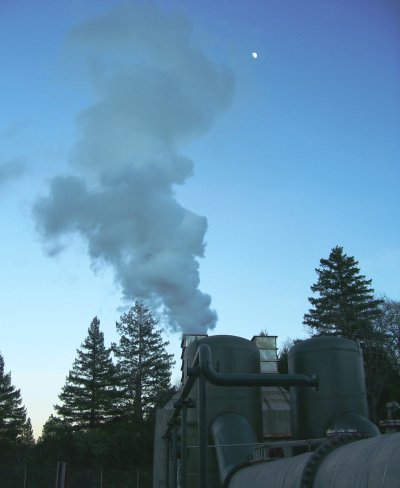
KELSEYVILLE – A long-closed geothermal plant is expected to be online once again in early March.
Santa Monica-based US Renewables Group (USRG) purchased the Bottle Rock Power plant in September 2005, said Lee Bailey, USRG's co-founder and a partner in the firm.
USRG is involved with a number of alternative power operations, said Bailey. Their holdings include biomass, landfill methane, ethanol and biodiesel plants.
Bottle Rock is USRG's only geothermal plant, Bailey said, although the company is proposing to build two to three other such plants in California.
Last June, Riverstone Holdings and The Carlyle Group, in the form of the Carlyle/Riverstone Renewable Energy Infrastructure Fund I, acquired from USRG a "significant stake" in the Bottle Rock plant, according to a company statement.
Riverstone is a New York-based private equity firm that focuses on energy and power.
The Carlyle Group, based in Washington, D.C., is a multinational firm that has major defense and aerospace contracts. Some of those connected with the company over the years have included former President George Bush and Secretary of State James Baker, along with former British Prime Minister John Major. Some critics of the current war in Iraq have accused the company of war profiteering.
The Bottle Rock plant was built and operated by the Department of Water Resources (DWR), said Bailey, who used the power for its own operations.
Gary Snedaker, the Bottle Rock plant's project manager, said DWR closed the plant in 1990 due to a "lack of steam." However, he said, the plant required significant repair, cleaning and new drilling, and DWR wasn't receiving very much compensation for the energy it was producing.
When the plant shut down at noon on Sept. 16, 1990, it was producing 12 megawatts, said Snedaker, although its capacity is 55 megawatts, a level it had operated at when it opened in 1985.
Fifty-five megawatts, he said, can power about 55,000 homes, he said. When the plant comes back online, it will produce 20 megawatts.
"We fully intend on getting the plant past 30 megawatts," said Snedaker.
Bailey said USRG already has an exclusive contract with Pacific Gas & Electric, who will purchase the power the plant generates.
After DWR closed the plant, Bailey said, it changed hands, eventually purchased for $5 million by partners from Little Rock, Ark., and New Orleans.
Those owners, he said, were found to be involved in an illegal pyramid scheme scheme, and were arrested by the Federal Bureau of Investigation. At the same time, he said, the Securities Exchange Commission put the plant into trusteeship.
Bailey said USRG found out about the plant and bid for it through court proceedings.
The purchase was scheduled to close Sept. 1, 2005, but Bailey said the stock certificates and ownership documents were located in New Orleans. In a safe. Underwater.
USRG had to wait until the documents could be retrieved and brought to California, said Bailey; in the mean time, more bidders were trying to come forward.
"It was a colorful transaction," he said.
Plant renovation, said Bailey, began in February 2006. The three-story plant is located on 160 acres that are leased from the Coleman family.
An East Coast native, Snedaker is partner in Integral Energy management, a company partially owned by USRG that has the Bottle Rock plant's operations and maintenance contract. He was sent out to lead the renovation because of his extensive experience with energy production, from coal and gas turbine plants to a Nevada geothermal plant.
Snedaker said when the plant was closed, some of the major equipment was mothballed, and the geothermal wells plugged. For the most part, he said, most of the major pieces of equipment had been left sitting, with little attention.
There's been a lot of work involved in getting the plant back online, said Snedaker.
"It has been a significant overhaul," he said. "We have gone over every system in the plant."

When DWR operated the plant, Snedaker said, they had 10 production wells that produced steam. DWR had plugged those wells, seven of which have been successfully reopened, Snedaker said, and two new ones are now being drilled.
The wells, between 8,000 and 9,000 feet deep, produce water that averages 345 degrees, he said. When the plant reaches the 30 megawatt level, it will produce between 500,000 and 600,000 pounds of steam per hour.
The plant's 19 permanent employees are local, said Snedaker, with a former Calpine employee appointed to the plant manager spot.
There have been a number of regulatory requirements at all different levels of government, including county and state, in order to get the plant back producing geothermal power again, said Snedaker.
Those included public hearings, he said, which had good turnout.
"The residents of this area are very well-informed about geothermal," he said.
The result was intelligent questions. "We were very pleased with the feedback from the community," he said.
That doesn't mean there were no objections or concerns, and Snedaker.
However, he said, community members treated them fairly with their questions. The public hearings were held this past September, he said, and the plant eventually got the approval to move forward.
The company doesn't anticipate concerns with increased seismic activity as a result of geothermal power production, although that concern has been raised in the community in recent years.
Bailey said he doesn't believe there's any evidence to show that steam reinjection increases seismic activity.
However, Calpine has acknowledged that reinjection at the Geysers has increased frequency and magnitude of seismic activity in the area.
The Web site for The Geysers, owned by Calpine, states: “The phenomenon of seismicity associated with geothermal power production has been known and acknowledged for decades. With the expanded geothermal development beginning in the in the 1970's, there was a measurable increase in the frequency of 'microearthquakes,' or earthquakes registering under 3.0 on the Richter scale.”
When it comes to geothermal production, Snedaker said Lake County is a key area.
"This is the largest area of geothermal in the world," he said.
E-mail Elizabeth Larson at This email address is being protected from spambots. You need JavaScript enabled to view it..
{mos_sb_discuss:2}

 How to resolve AdBlock issue?
How to resolve AdBlock issue? 





